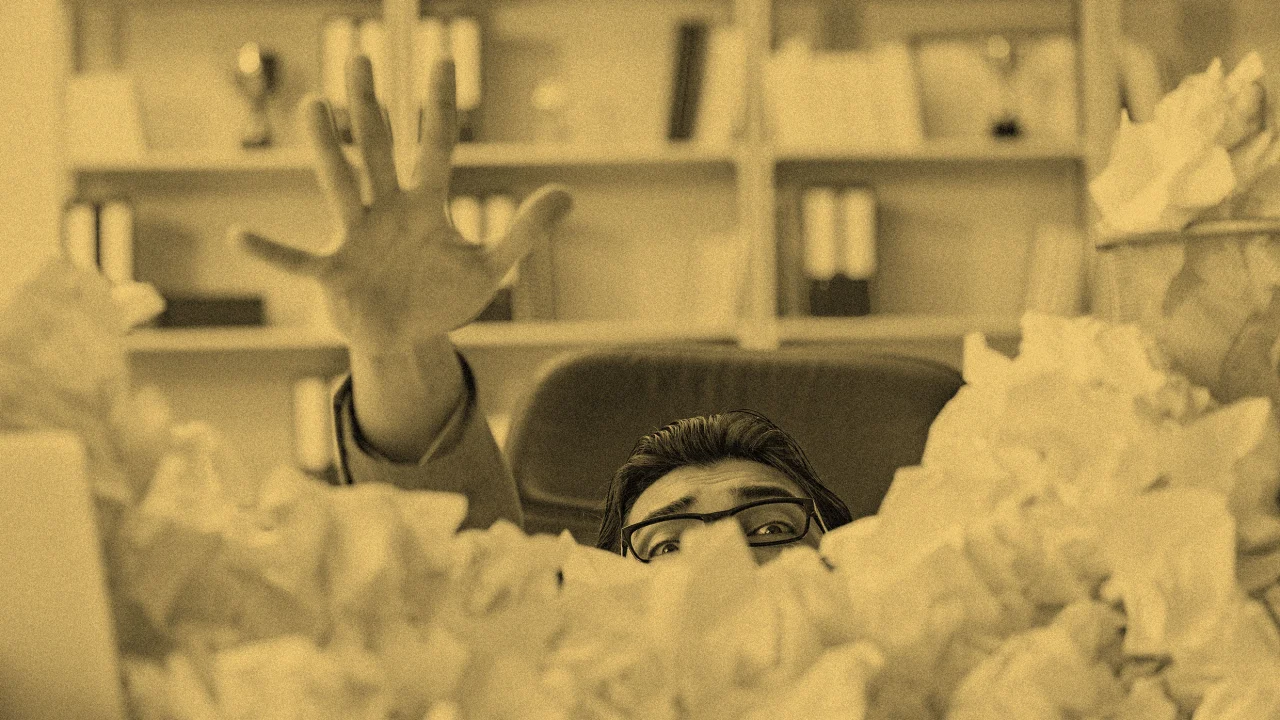How to get your stressed-out team past the ‘frustration threshold’
In my work, I frequently observe teams whose purpose is to provide top-level service fall into frustration with their inability to deliver. With stress coming from a lack of support from their workplace’s practices, communication, or training, I can empathize. Studies find that workplace burnout is at unprecedented levels, and with layoffs forcing workers to handle multiple roles, emotionally exhausted teams deserve support to carry on. With frustrated customers being redirected to apps, endless hold times, or inadequate self-service forums that can’t address complex problems, we need solid teams to help us with our customer-facing problems. When trapped in bureaucratic dysfunction, even high-performing teams feel defeated by their inability to create solutions. Despite advanced technologies, research shows employees spend significant time frustrated by organizational processes and policies that block their progress. And when customers experience these stall-outs, it translates to sinking loyalty and profits. Why Workplace Productivity Is Falling In fact, a recent study from Gallup found the average knowledge worker spends nearly 10 hours each week navigating internal processes and bureaucracy, which translates to 25% of their total workweek. Referred to as the “productivity tax,” these findings revealed that 77% of employees report differing levels of frustration with organizational barriers; only 23% feel organizational procedures support employee productivity. It’s not just employees that are discouraged. Larger enterprises lose up to $15 million annually per 1,000 employees due to process inefficiencies and bureaucratic friction. That’s not to mention the emotional tolls employees suffer—like spikes in anxiety and cortisol levels—from handling angry customers. The result: sagging motivation to keep trying to make progress, often culminating in a sense of defeat by the very systems that are supposed to help employees complete their work. How can teams exhausted from these experiences stay agile to spark the needed innovative work-arounds that will solve customer and morale problems quickly? Three proven strategies can give teams the needed momentum to not give up. A Stressed Team on the Frustration Threshold At her bank, Sara’s team struggled with routine foreign account payments for premium clients. The process required verbal approval from the account holder plus two digital approvals, making it cumbersome for busy executives who often confirmed without reviewing transactions. “Multimillion-dollar transfers disappeared for days. Some accounts experienced bounce-backs weeks later due to system errors,” one banking team member said. Yet Sara’s team always cited the same reasons as the source of their stall-outs: The Dodd-Frank Act requirements for international transfers leave us no options to do better. For years, multistep confirmations have been used by banks, exacerbating banking client’s frustrations. Already wasting thousands of dollars in lost time, the team asked a key question: Why is transferring the same amount, to the same account, on the same day each month so complicated? Interrupting the Team Frustration Pattern The breakthrough came not from accepting established limitations, but from three key elements working in concert. 1. Identifying the right people. The team-based resolution accelerated three essential perspectives from a small team of the right people close to the problem: A customer with a problem, perplexed by a seemingly simple task, asking the question, “Isn’t there a better way by now?” An operations specialist with deep systems knowledge A customer service representative willing to dig deeper into the maze of systems to check assumptions and ask, “What’s missing in order to do this?” All parties unwilling to accept the answer, “Sorry, that’s just how it works.” This combination provided the authority, expertise, and motivation needed to pursue nonstandard solutions. 2. Safely asking the same question differently (and repeatedly). Returning to one fundamental question, and reframing it in a psychologically safe way, the solution came from a practice referred to as shifting frames, coupled with not accepting explanations about regulations and international banking protocols. “There must be a better way. What are we missing?” This refusal to normalize inefficiency eventually cracked the case. After hearing the same question framed slightly differently multiple times, the customer service representative looped in an operations specialist who recognized, “Wait—is this account a certain type? Because if so . . .” The aha moment came not from new information, but from seeing existing information through a different lens—precisely because they refused to stop questioning. 3. Problem-solving collaboratively with a shared goal. What made this experience remarkable wasn’t that one person found the solution. Rathe

In my work, I frequently observe teams whose purpose is to provide top-level service fall into frustration with their inability to deliver. With stress coming from a lack of support from their workplace’s practices, communication, or training, I can empathize.
Studies find that workplace burnout is at unprecedented levels, and with layoffs forcing workers to handle multiple roles, emotionally exhausted teams deserve support to carry on. With frustrated customers being redirected to apps, endless hold times, or inadequate self-service forums that can’t address complex problems, we need solid teams to help us with our customer-facing problems.
When trapped in bureaucratic dysfunction, even high-performing teams feel defeated by their inability to create solutions. Despite advanced technologies, research shows employees spend significant time frustrated by organizational processes and policies that block their progress. And when customers experience these stall-outs, it translates to sinking loyalty and profits.
Why Workplace Productivity Is Falling
In fact, a recent study from Gallup found the average knowledge worker spends nearly 10 hours each week navigating internal processes and bureaucracy, which translates to 25% of their total workweek. Referred to as the “productivity tax,” these findings revealed that 77% of employees report differing levels of frustration with organizational barriers; only 23% feel organizational procedures support employee productivity.
It’s not just employees that are discouraged. Larger enterprises lose up to $15 million annually per 1,000 employees due to process inefficiencies and bureaucratic friction. That’s not to mention the emotional tolls employees suffer—like spikes in anxiety and cortisol levels—from handling angry customers. The result: sagging motivation to keep trying to make progress, often culminating in a sense of defeat by the very systems that are supposed to help employees complete their work.
How can teams exhausted from these experiences stay agile to spark the needed innovative work-arounds that will solve customer and morale problems quickly? Three proven strategies can give teams the needed momentum to not give up.
A Stressed Team on the Frustration Threshold
At her bank, Sara’s team struggled with routine foreign account payments for premium clients. The process required verbal approval from the account holder plus two digital approvals, making it cumbersome for busy executives who often confirmed without reviewing transactions. “Multimillion-dollar transfers disappeared for days. Some accounts experienced bounce-backs weeks later due to system errors,” one banking team member said. Yet Sara’s team always cited the same reasons as the source of their stall-outs: The Dodd-Frank Act requirements for international transfers leave us no options to do better.
For years, multistep confirmations have been used by banks, exacerbating banking client’s frustrations. Already wasting thousands of dollars in lost time, the team asked a key question: Why is transferring the same amount, to the same account, on the same day each month so complicated?
Interrupting the Team Frustration Pattern
The breakthrough came not from accepting established limitations, but from three key elements working in concert.
1. Identifying the right people. The team-based resolution accelerated three essential perspectives from a small team of the right people close to the problem:
- A customer with a problem, perplexed by a seemingly simple task, asking the question, “Isn’t there a better way by now?”
- An operations specialist with deep systems knowledge
- A customer service representative willing to dig deeper into the maze of systems to check assumptions and ask, “What’s missing in order to do this?”
- All parties unwilling to accept the answer, “Sorry, that’s just how it works.”
This combination provided the authority, expertise, and motivation needed to pursue nonstandard solutions.
2. Safely asking the same question differently (and repeatedly). Returning to one fundamental question, and reframing it in a psychologically safe way, the solution came from a practice referred to as shifting frames, coupled with not accepting explanations about regulations and international banking protocols.
“There must be a better way. What are we missing?”
This refusal to normalize inefficiency eventually cracked the case. After hearing the same question framed slightly differently multiple times, the customer service representative looped in an operations specialist who recognized, “Wait—is this account a certain type? Because if so . . .”
The aha moment came not from new information, but from seeing existing information through a different lens—precisely because they refused to stop questioning.
3. Problem-solving collaboratively with a shared goal. What made this experience remarkable wasn’t that one person found the solution. Rather, it was how three people—frustrated but committed to finding an answer—worked together with increasing focus.
The answer that the customer had received for nearly six months from other banking team members transformed into “How can we make this work?”—reframed from explaining why it wouldn’t.
The Breakthrough Formula
The resolution revealed a repeatable formula for breaking through frustrating problems: Persistence + Right People + Questioning Assumptions = Breakthrough Solutions. This approach works because it addresses the three common failure points in problem-solving:
- Giving up too soon. Most teams stop at the first or second “no,” never reaching the insight that comes after sustained effort.
- Involving the wrong people. Problems often stall because the people with the expertise, authority, or motivation to solve them aren’t in the conversation.
- Accepting false constraints. Teams frequently operate within imagined limitations, never questioning whether the rules that appear to block progress actually apply to their specific situation.
So how can you apply these principles to your own seemingly intractable problems?
Create psychological safety around persistent questioning. The most valuable question wasn’t the first or second asking about alternatives—it was the fifth. Eliminate fear by creating an environment in which people feel comfortable asking the same fundamental questions repeatedly, knowing that breakthrough insights often emerge from persistent inquiry.
Bring multiple expertise levels to stubborn problems. While the banking example is a simple one, it’s also one many can relate to. The long-standing issue wasn’t solved by a single technical specialist, frontline employee, or customer pressure. It required the combination of all three perspectives.
Focus on the desired outcome, not the process. “Throughout the team’s interactions, focus was maintained on the end goal (completing the transaction) rather than debating the merits of existing processes,” Sara explained. This orientation prevented the team from getting lost in explaining why things weren’t working and kept them searching for how they could find a solution.
The Payoff of Productive Persistence
The difference between problems that linger forever and those that get solved quickly often comes down to how teams approach the frustration threshold. Average teams give up when initial solutions fail. Exceptional teams recognize that the moment of greatest frustration often precedes the breakthrough.
By assembling the right people, maintaining persistent questioning, and collaborating with a solution focus, even the most frustrating bureaucratic tangles can unravel—revealing pathways that were available all along, just waiting for the right combination of perspectives to discover them.
This isn’t just about banking transactions or customer service. It’s a fundamental approach to organizational effectiveness that transforms frustration from a signal to give up into a signal to dig deeper, ask better questions, and find the people who can help you see the problem differently. In 2025 and beyond, the competitive advantage belongs not to organizations with perfect processes, but to those with teams who excel at breaking through barriers when those processes inevitably fail.


























































































































































